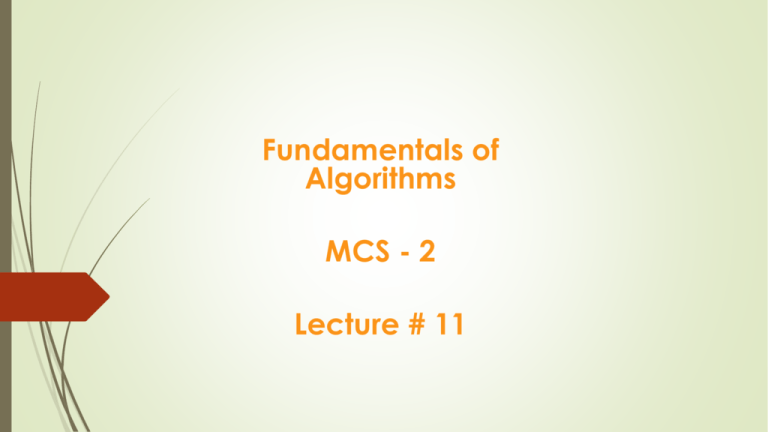Merge Sort
advertisement

Fundamentals of Algorithms MCS - 2 Lecture # 11 Merge Sort Using Divide & Conquer Strategy Merge Sort Split array A[0..n-1] into about equal halves and make copies of each half in arrays B and C. (Divide) Sort arrays B and C recursively. (Conquer) Merge sorted arrays B and C into array A as follows: (Combine) Repeat the following until no elements remain in one of the arrays: compare the first elements in the remaining unprocessed portions of the arrays copy the smaller of the two into A, while incrementing the index indicating the unprocessed portion of that array Once all elements in one of the arrays are processed, copy the remaining unprocessed elements from the other array into A. Merge Sort: Example 1 8 3 2 9 7 1 5 4 8 3 2 9 8 3 8 7 1 5 4 2 9 3 2 3 8 71 9 2 9 7 5 4 1 5 1 7 2 3 8 9 4 5 1 4 5 7 1 2 3 4 5 7 8 9 4 Divide & Conquer Combine or Merge Merge Sort: Example 2 Pseudo-code of Merge Sort Algorithm Division Part MERGE-SORT (Array A, integer left, integer right) 1 IF (left < right) 2 THEN mid ← (left + right) / 2 3 MERGE-SORT (Array A, left, mid) 4 MERGE-SORT (Array A, mid +1, right) // sort A[mid +1……right] 5 MERGE-SORT (Array A, left, mid, right)// merge two pieces // sort A[left…… mid] Pseudo-code of Merge Sort Algorithm Combining Part MERGE-SORT (Array A, int left, int mid, int right) 1 int B[left……right]; int i ← k ← left; int j ← mid + 1 2 WHILE (i ≤ mid) AND (j ≤ right) 3 4 5 DO IF (A[i] ≤ A[j]) THEN B[k++] ← A[i++] ELSE B[k++] ← A[j++] 6 WHILE (i ≤ mid) 7 DO B[k++] ← A[i++] 8 WHILE (j ≤ right) 9 DO B[k++] ← A[j++] 10 FOR i ← left to right 11 DO A[i] ← B[i] Analysis of Merge Sort First consider the running time of procedure Merge(A, left, mid, right). Let n = right – left + 1 denotes the total length of both left and right subarrays, i.e., sorted pieces. The merge procedure contains 4 loops, no one is nested. Each loop can be executed at most n times. Thus running time of merge is Θ(n). Let T(n) denotes the worst case running time of MergeSort on an array of length n. If we call MergeSort with an array containing a single item (n=1), then the running time is constant. We can just write T(n)=1, ignoring all constants. For n > 1, MergeSort splits into 2 halves, sorts the two and then merges them together. The left half is of size[n/2] and the right half is [n/2] How long does it take to sort elements in sub-array of size[n/2]? Analysis of Merge Sort How long does it take to sort elements in sub-array of size[n/2]? We do not know this but because [n/2] < n for n > 1, we can express this as T([n/2]). Similarly the time taken to sort right sub-array is expressed as T(n/2). In conclusion, we have T(n)=1 if n=1, otherwise T([n/2])+T([n/2])+n This is called Recurrence Relation, i.e., a recursively defined function. Good Luck ! ☻





